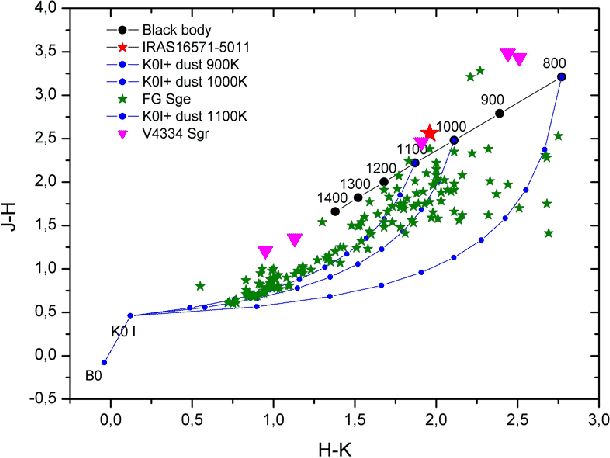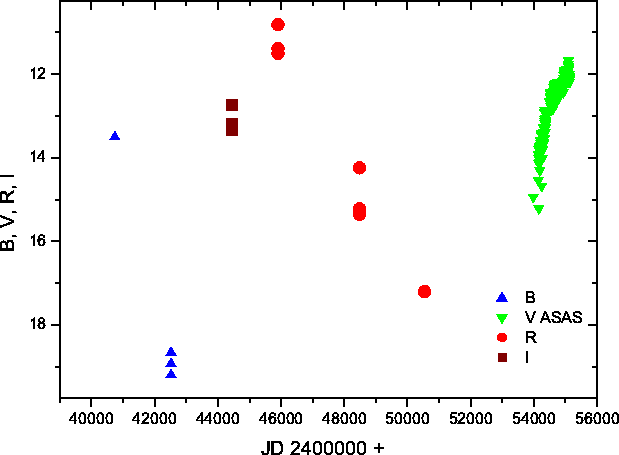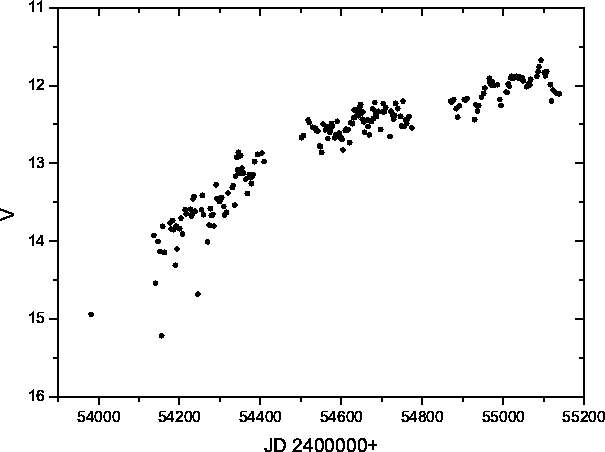|
Peremennye Zvezdy (Variable Stars) 31, No. 6, 2011 Received 3 November; accepted 25 November.
|
Article in PDF |
NSV 08092: an Unusual R CrB Star or a Post-AGB Object at the "Born-again" Stage?
E. V. Kazarovets1, V. P. Arkhipova2
- Institute of Astronomy, Russian Academy of Sciences,
Pyatnitskaya Str. 48, 119017 Moscow, Russia; e-mail:
helene@inasan.ru
- Sternberg Astronomical Institute, M.V. Lomonosov Moscow University, University Ave. 13, 119992 Moscow, Russia
| We have recovered the "lost" variable star NSV 08092 = HV 8988. Form archive data, its brightness variations are rather unusual. In some aspects, it resembles R CrB stars, but it can be an analog of the famous unusual post-AGB star FG Sge. |
1. Introduction
During the recent years, one of the authors (EVK) works on the program aimed at recovery and subsequent study of stars from the NSV catalog (Kukarkin et al., 1982). She found several hundred variable stars, possible identifications for stars suspected of variability by different discoverers in the first half of the 20th century. In the absence of any published finding charts, these stars were effectively "lost" for observations. Digitized sky images (the STScI Digitized Sky Survey, the USNO Image and Catalogue Archive) and databases of CCD observations from automatic telescopes that became available in the recent decades not only permit to recover many lost variables but also to study the character of brightness variations, to determine variability types for many of them (Kazarovets and Pastukhova, 2008-2011).
In this paper, we present a study of the star HV 8988 (=
NSV 08092), discovered as a variable by Luyten (1935). Despite
the large announced variability amplitude
(13![]() 3-
3-
![]() pg), no identification candidate for this
Luyten's variable was suggested so far.
pg), no identification candidate for this
Luyten's variable was suggested so far.
2. Identification
We began our search for HV 8988 with "blinking" two ![]() red images from the USNO Image and Catalogue Archive,
centered at the 1900.0 coordinated published by Luyten. A third
red-light image was then found in the Aladin Sky Atlas (Centre de
Données astronomiques de Strasbourg). This comparison of three
images revealed a large-amplitude variable star rather close from
the position published by Luyten, in 0
red images from the USNO Image and Catalogue Archive,
centered at the 1900.0 coordinated published by Luyten. A third
red-light image was then found in the Aladin Sky Atlas (Centre de
Données astronomiques de Strasbourg). This comparison of three
images revealed a large-amplitude variable star rather close from
the position published by Luyten, in 0![]() 6 to the south-east.
Figure 1a,b presents the red-light images of the surroundings of
HV 8988 from the ESO survey of the southern sky (July 26, 1984,
epoch 1984.555), where the star is at its maximum light, and from
the SERC survey (March 31, 1997, epoch 1997.248), where the star
is at minimum.
6 to the south-east.
Figure 1a,b presents the red-light images of the surroundings of
HV 8988 from the ESO survey of the southern sky (July 26, 1984,
epoch 1984.555), where the star is at its maximum light, and from
the SERC survey (March 31, 1997, epoch 1997.248), where the star
is at minimum.
 |
Fig. 1. The red-band images of HV 8988. (a): ESO, epoch 1984.555, the star is in the center; (b): SERC, epoch 1997.248. North is on top, east is to the left. The side of the square is 5 minutes of arc. |
The star is not present in the GSC catalog (epoch 1975.298) or in
the USNO-A2.0 catalog (epoch 1979.930). It enters the UCAC3
catalog as 3UC 080-305383, its accurate coordinates are:
![]() ,
,
![]() (J2000.0). The catalog quotes the star's brightness,
(J2000.0). The catalog quotes the star's brightness,
![]() , measured in yellow light (
, measured in yellow light (![]() , in the
0.579-0.642 nm band). The epoch in the catalog, 1998.310, is the
mean epoch of astrometric measurements; unfortunately, it does not
coincide with the time of the brightness estimate.
, in the
0.579-0.642 nm band). The epoch in the catalog, 1998.310, is the
mean epoch of astrometric measurements; unfortunately, it does not
coincide with the time of the brightness estimate.
In the 2MASS catalog, this is a star with a large IR excess:
![]() ,
,
![]() ,
,
![]() ,
,
![]() for
the epoch 1999.483. The IRAS fluxes at 12, 25, and 60
for
the epoch 1999.483. The IRAS fluxes at 12, 25, and 60 ![]() m are
respectively 1.68, 0.91, 0.94L Jy, the point-source-catalog name
being IRAS 16571-5011. In the IRAS two-color diagram [12]-[25],
[25]-[60]
m are
respectively 1.68, 0.91, 0.94L Jy, the point-source-catalog name
being IRAS 16571-5011. In the IRAS two-color diagram [12]-[25],
[25]-[60] ![]() m, the star is among R CrB variables and planetary
nebulae.
m, the star is among R CrB variables and planetary
nebulae.
3. Variability
We measured the brightness of HV 8988 from all available archive
images (or photographic atlas maps) by comparison to surrounding
stars with known ![]() and
and ![]() magnitudes from the USNO-A2.0
catalog. The results are presented in the Table; its columns
contain the archive name, image epoch, our magnitude estimate, and
its photometric band. The last column contains magnitudes from
catalog archives, measured by other authors using the same images.
magnitudes from the USNO-A2.0
catalog. The results are presented in the Table; its columns
contain the archive name, image epoch, our magnitude estimate, and
its photometric band. The last column contains magnitudes from
catalog archives, measured by other authors using the same images.
The star is not listed in the Pojmanski et al. (2006) catalog of
variable stars discovered in the ASAS-3 survey in 2002-2006,
meaning that the star was below the limiting magnitude of the
survey,
![]() . It became visible after JD 2454000, and ASAS
data show its subsequent brightening to the maximum at
. It became visible after JD 2454000, and ASAS
data show its subsequent brightening to the maximum at
![]() (JD 2455093.5). The brightness stayed at this level till the end
of publicly available ASAS observations for 40 more days, i.e.
till November, 2009.
(JD 2455093.5). The brightness stayed at this level till the end
of publicly available ASAS observations for 40 more days, i.e.
till November, 2009.
The smoothly brightening light curve is superposed with variations
having an amplitude up to 0![]() 5 and a timescale from dozens of
days to a hundred days. They were best expressed in 2009. We were
not able to derive a cycle length for these variations.
5 and a timescale from dozens of
days to a hundred days. They were best expressed in 2009. We were
not able to derive a cycle length for these variations.
Figure 2 presents the photometric measurements of HV 8988 from
1970 till 2009; Fig. 3 is the detailed ![]() -band light curve from
2007 to 2009 based on the ASAS archive observations. Our analysis
of the photometry demonstrates that the brightness variation
amplitude is at least
-band light curve from
2007 to 2009 based on the ASAS archive observations. Our analysis
of the photometry demonstrates that the brightness variation
amplitude is at least
![]() in the blue and red spectral
ranges. The brightness maxima are recurrent, there were at least
three of them in 40 years. The rate of egress from the minimum can
be reliably estimated only from the ASAS data, being
in the blue and red spectral
ranges. The brightness maxima are recurrent, there were at least
three of them in 40 years. The rate of egress from the minimum can
be reliably estimated only from the ASAS data, being
![]() in
in ![]() days, though it could have been higher prior to
2007.
days, though it could have been higher prior to
2007.
The optical-range color index of HV 8988 remains unknown because
no simultaneous multiband observations are available. The maximal
interstellar extinction towards HV 8988 (
![]() ,
,
![]() ) is
) is ![]() , or
, or
![]() , as estimated
using maps from Schlegel (1998).
, as estimated
using maps from Schlegel (1998).
| Archive, atlas | Epoch | Our estimate | Band | Other estimates |
| Vehrenberg atlas | 1970.437 | 13.5 | - | |
| SERC |
1975.297 | 19.2 | 18.95 (GSC2.3) | |
| 18.66 (SuperCOSMOS) | ||||
| SERC |
1980.542 | - | 12.73 (SuperCOSMOS) | |
| 13.20 (USNO-B1.0) | ||||
| 13.33 (GSC2.3) | ||||
| ESO |
1984.555 | 11.5 | 10.81 (SuperCOSMOS) | |
| 11.38 (USNO-B1.0) | ||||
| AAO |
1991.608 | 15.3 | 14.24 (SuperCOSMOS) | |
| 15.22 (USNO-B1.0) | ||||
| 15.35 (GSC2.3) | ||||
| SERC |
1997.248 | 17.2 | - | |
| Kodak CCD images | - | 12.38 (UCAC2) | ||
| 12.63 (UCAC3) | ||||
|
4. Discussion
Taking into account the presence of deep fadings as well as
brightness variations (pulsations?) with an amplitude about 0![]() 5
and a timescale of dozens of days, it is reasonable to assume that
the star can belong to R CrB variables, so that we observed it
emerging from a deep dust minimum in 2007-2009. The presence of
a large excess in the near-IR range as well as at 12-25
5
and a timescale of dozens of days, it is reasonable to assume that
the star can belong to R CrB variables, so that we observed it
emerging from a deep dust minimum in 2007-2009. The presence of
a large excess in the near-IR range as well as at 12-25 ![]() m
for HV 8988 also indicates its similarity to R CrB stars. In the
m
for HV 8988 also indicates its similarity to R CrB stars. In the
![]() range, these stars feature the presence of hot dust, with
the temperature
range, these stars feature the presence of hot dust, with
the temperature ![]() K, formed during sporadic ejections of
matter.
K, formed during sporadic ejections of
matter.
Figure 4 displays the ![]() ,
, ![]() two-color-diagram with the
positions of HV 8988 (big red asterisk) and blackbodies with
temperatures from 800 to 1400 K (straight line) marked. We see
that the 2MASS observations, made in 1999, give the dust
temperature about 1000 K, and all the light in this range comes
from the dust component of HV 8988. Unfortunately, we have no data
on the star's optical brightness in 1999.
two-color-diagram with the
positions of HV 8988 (big red asterisk) and blackbodies with
temperatures from 800 to 1400 K (straight line) marked. We see
that the 2MASS observations, made in 1999, give the dust
temperature about 1000 K, and all the light in this range comes
from the dust component of HV 8988. Unfortunately, we have no data
on the star's optical brightness in 1999.
 |
Fig. 4.
The |
Brightness variations with amplitudes of 0![]() 5 are not typical of
classical R CrB stars, whose amplitudes are usually much lower,
though it is pulsations and shock waves that probably cause
ejection of matter and subsequent dust condensation. In this
sense, the photometric behavior of HV 8988 resembles that of
FG Sge, the central star of a planetary nebula that experienced
the last helium flash of its shell source some 100 years ago
(Arkhipova et al. 2009a). By now, FG Sge has returned to the
region of AGB supergiants. Since 1992, it systematically exhibits
deep fadings due to ejection of dust clouds, continuing to pulsate
with a period about 110 days and a variable
5 are not typical of
classical R CrB stars, whose amplitudes are usually much lower,
though it is pulsations and shock waves that probably cause
ejection of matter and subsequent dust condensation. In this
sense, the photometric behavior of HV 8988 resembles that of
FG Sge, the central star of a planetary nebula that experienced
the last helium flash of its shell source some 100 years ago
(Arkhipova et al. 2009a). By now, FG Sge has returned to the
region of AGB supergiants. Since 1992, it systematically exhibits
deep fadings due to ejection of dust clouds, continuing to pulsate
with a period about 110 days and a variable ![]() -band amplitude of
0
-band amplitude of
0![]() 5-1
5-1![]() (Arkhipova et al. 2009b).
(Arkhipova et al. 2009b).
Small green asterisks in Fig. 4 are infrared data for FG Sge from observations by Taranova and Shenavrin (2002) and Taranova (2010) performed after 1992; the blue curves represent combined radiation of a K0 supergiant and dust at different temperatures. The behavior of FG Sge in the two-color diagram (Fig. 4) is quite similar to that of typical R CrB stars during their dust fadings (Feast 1997), and thus we describe its state after 1992 as an R CrB evolution phase. The difference is only in the presence of an old planetary nebula around FG Sge, while R CrB stars do not possess nebulae. Possibly, HV 8988 could have lost its nebula at the last flash of its helium shell source, so that it is now difficult to distinguish it from classical R CrB stars.
If HV 8988 is considerably hotter than FG Sge, we find no indication for it in the IR two-color diagram (Fig. 4). As already mentioned, no optical data are available for the time of 2MASS observations.
Note that another analog of FG Sge, the Sakurai star V4334 Sgr, was completely covered with dust because of the last thermal pulse of its shell source in 1999, and it has not yet emerged from the deep brightness minimum due to the very large depth of the dust envelope. The position of V4334 Sgr in 1998-1999 is plotted in Fig. 4 according to Duerbeck et al. (2000).
Further photometry and especially spectroscopy of HV 8988 is very needed.
Acknowledgments: This study was supported by the program "Origin and Evolution of Stars and Galaxies" of the Presidium of Russian Academy of Sciences. The authors wish to thank N. Samus for his valuable assistance.
References:
Arkhipova V.P., Esipov V.F., Ikonnikova N.P., 2009a, Astron. Letters, 35, 633
Arkhipova V.P., Esipov V.F., Ikonnikova N.P. et al., 2009b, Astron. Letters, 35, 354
Duerbeck H.W., Liller W., Sterken C. et al., 2000, Astron. J., 119, 2360
Feast M.W., 1997, Mon. Not. Roy. Astron. Soc., 285, 339
Kazarovets E.V., Pastukhova E.N., 2008-2011, Peremennye Zvezdy Prilozhenie, 8, Nos. 45 and 51; 9, Nos. 3 and 6; 10, No. 31; 11, Nos. 7 and 29
Kukarkin B.V., Kholopov P.N., Artiukhina N.M., et al., 1982, New Catalogue of Suspected Variable Stars, Moscow: Nauka
Luyten W.J., 1935, Astron. Nachr., 256, 325
Pojmanski G., Maciejewski G., Pilecki B., Szczygiel D., 2006 (2006yCat.2264…OP)
Schlegel D.J., 1998, Astrophys. J., 500, 525
Taranova O.G., 2010, private communication
Taranova O.G., Shenavrin V.I., 2002, Astron. Rep., 46, 1010

